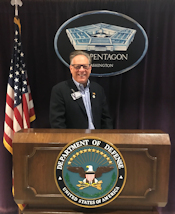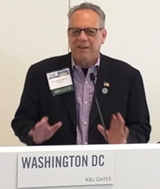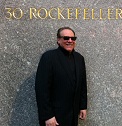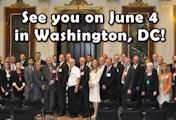NanoBCA Interview with Nanotech Pioneer Dr. Malcolm Gillis
Posted on June 12th, 2014 | No Comments »
Dr. Malcolm Gillis, a distinguished economist, served as President of Rice University from 1993 to 2004 and has been at the forefront of international research collaboration, working with Lord David Sainsbury when he was Minister for Science, to pioneer a truly international approach between the leading research academics working in nano science in the U.S., U.K. and Europe at leading research institutions.
On June 3rd, Dr. Gillis gave a lecture at The Royal Institution of Great Britain.
NanoBCA
Please tell us about the genesis of your lecture concerning the convergence of Nano, Bio and Info.
Dr. Gillis
This is the latest in a long series of lectures I have given over the last two decades about the promise of nanotechnology. My involvement in nano at Rice during that exciting time when Dr. Richard Smalley’s team was conducting extraordinary work, and my subsequent involvement in the nano community has afforded me the ability to observe progress and trends not only in the U.S. but worldwide. During that time, I have had the good opportunity to engage with leaders in the field in Germany, Ireland, Scotland and England, among others. It’s been an enlightening and inspiring journey for me. The goal of the lecture is to educate the general public, and to start a dialogue with a broader array of stakeholders, of the extraordinary possibilities that are borne at the intersection nano, bio, and information technologies.
NanoBCA
How did you come to work with Lord Sainsbury and what are the specific outcomes for the U.K. and Texas nano communities?
Dr. Gillis
I first met Lord Sainsbury in the late 1990s on a trip to the U.K. to give a lecture at the Royal Academy in Edinburgh, after which Lord Sainsbury and I met in London to explore potential collaborations in the field of nanotechnology. I remember being struck by how extremely well prepared he was on the subject. In just thirty minutes time, we were able to agree and establish the Nano Bio Collaborative on Research which involved eight British universities and ten Texas research universities. The Collaborative launched in 2002. Lord Sainsbury provided several million pounds to the effort. The Collaborative was extremely successful and lasted for ten years.
NanoBCA
The 21st Century Nanotechnology R&D Act was signed into law by President Bush in December of 2003. Since then, the U.S. Government has spent approximately $20 billion on nanotechnology R&D. This investment was spread over 9 major U.S. agencies. What do you believe are some of the major accomplishments as they relate to nanobio?
Dr. Gillis
There have been so many notable achievements. Too many to cover here but let me mention a few that stand out in my mind. There was a $2.9 million grant from NIH to fund research at Rice and Baylor College of Medicine for neuro-vascular regeneration which has generated great results in that field. Another grant was provided in the amount of £6.7 million from BPSRC for research at University College London and Swansea for research in interactive medical devices. The Center of Nano Health was established in Wales with a£1.9 million grant from BPSRC. And there were another eight or so grants in the range of $30 million for funding other areas of research.
You mention the signing of the 21st Century Nanotechnology R&D Act in 2003. Neal Lane, who is at Rice with me, and was the former Provost at Rice and former head of the NSF was very instrumental in getting that legislation passed. That legislation set in motion four generations of evolution in nano: first, the immediate effect of moving from prior-2000 (buckeyballs and nanotubes) to 2nd generation (2000-2005) of more active nanoparticles, and 3rd and now 4th. The National Nanotechnology Initiative was absolutely instrumental. According a recent article in the journal Nature Nanotechnology, there are now some 507 nanotech firms worldwide. Two-thirds of those are small firms, which is where a lot of truly great innovation occurs.
NanoBCA
Often we hear a variety of different opinions about the definition of “nanotechnology.” What’s your opinion?
Dr. Gillis
From my perspective, the definition of nanotechnology is broad and includes many biological innovations, because most anything that goes on in a human cell is “nature’s nanotechnology.”
NanoBCA
One of the participating agencies of the NNI is the NIH. What are some breakthroughs we can expect from NIH in the next 5-10 years?
Dr. Gillis
There have been some very significant advances in therapy and diagnostics which will continue to deliver tremendous results in the years ahead. For instance, novel techniques developed at Rice and other places that allow for the use of gold nanoshells to kill cancer cells. Also, advances that allow targeted delivery of cancer drugs to a single cell. Breakthroughs in early cancer cell detection will have a profound impact.
Unfortunately, due to woes in the federal budget, prospects for increased funding for NIH are not bright and will limit the possibility of breakthroughs. However, we will certainly continue to see breakthroughs in cancer treatment, biomarkers and tissue engineering. Lab-on-a-chip is also coming close to a reality. Human tissues married with nanowires create a type of cyborg tissue that might enable doctors to monitor changes in human tissue not imagined before. And, there are remarkable developments in building living tissue with 3D printing technologies. Genomics has already given us a complete parts list for humans. New advances in nano-bio-IT provide us with the extensive capability to manmake these parts.
In conclusion, the big picture for future breakthroughs is that most of these advances are the product of the convergence of nano, bio and information technologies. That convergence is a powerful force for innovation. That is the focus of my lecture in London on June 3rd.
NanoBCA
Dr. Gillis, thank you for your time and tremendous insight.
Thank you Dr. Gillis for your contributions to the nano community over the last decade.
Regards,
Vincent Caprio “Serving the Nanotechnology Community for Over a Decade”
Executive Director
NanoBusiness Commercialization Association
203-733-1949
vincent@nanobca.org
www.nanobca.org
www.vincentcaprio.org




